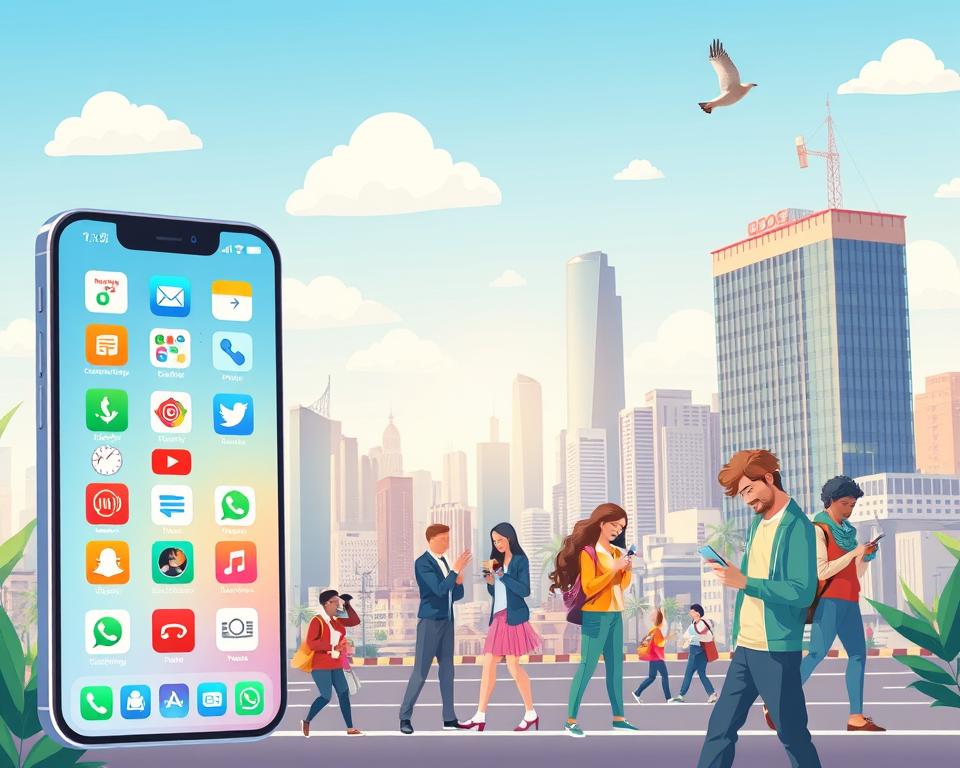
The Advantages and Disadvantages of Mobile Tech
Did you know that over 6.3 billion people worldwide own a mobile device, which translates to approximately 83% of the global population? This staggering statistic highlights the profound impact of mobile technology on our everyday lives. As mobile devices become increasingly integrated into our daily routines, understanding the mobile technology advantages and disadvantages is essential. From revolutionizing communication, work, and access to information, mobile technology has reshaped our social landscape. However, with these advancements come significant social implications and challenges. In this article, we’ll explore the pros and cons of mobile technology, revealing its multifaceted impact on our connected world.

Key Takeaways
- Mobile technology affects nearly everyone globally, with billions of users.
- The dual nature of mobile tech offers both benefits and challenges.
- Understanding mobile technology impact is crucial in our tech-driven lives.
- The evolution of mobile devices has changed personal and professional landscapes.
- Recognizing the pros and cons of mobile technology enables better decision-making.
Understanding Mobile Technology
Mobile technology refers to the tools and devices enabling communication and interaction through portable means. At its core, mobile technology includes smartphones, tablets, and mobile applications designed to enhance connectivity and access information on the go. The rapid development of mobile networks, particularly 4G and 5G, supports these devices, allowing seamless internet access and data transfer.
The benefits of mobile technology are extensive. Enhanced communication fosters connections between individuals and businesses globally. People can now engage with friends, family, and colleagues in real-time, regardless of geographical barriers. Mobile technology also opens doors to various applications, supporting tasks from productivity to entertainment.
However, certain drawbacks of mobile technology exist. Issues such as dependence on devices can lead to distractions in everyday life. Concerns around data privacy and security arise as more personal information becomes accessible through mobile applications. Understanding both the benefits and drawbacks of mobile technology provides a balanced perspective on its impact on daily life.

Mobile Technology Advantages and Disadvantages
Mobile technology has transformed the way people connect, communicate, and interact with the world around them. With the pros and cons of mobile technology becoming increasingly evident, it is important to assess both the benefits and drawbacks of this ubiquitous innovation. Users experience unparalleled connectivity, allowing immediate access to information and communication channels, which is one of the notable mobile technology advantages and disadvantages.
Convenience tops the list of benefits. Mobile devices enable users to browse the internet, send messages, and engage in social media all while on the move. This level of flexibility enhances productivity both in personal and professional settings. Despite this, the convenience brought by mobile technology can lead to potential pitfalls such as distraction and dependency. Many individuals find themselves continually checking notifications, which can disrupt their focus and affect mental well-being.
To better understand the balance between advantages and disadvantages, consider the following table:
| Advantages | Disadvantages |
|---|---|
| Instant connectivity | Distraction from tasks |
| Access to information anytime | Risk of dependency |
| Enhanced business operations | Privacy concerns |
| Convenient communication | Reduced face-to-face interactions |
Being aware of these mobile technology advantages and disadvantages promotes a mindful approach to usage. Users can leverage mobile technology’s benefits while minimizing risks through conscious engagement and setting boundaries.

The Rise of Mobile Devices
The rapid advancement of mobile technology has led to a significant transformation in how we communicate, work, and entertain ourselves. The growth of smartphone usage reflects this shift, showcasing how essential these devices have become in daily life. Reports indicate that over 90% of Americans now own a smartphone, a statistic that highlights the widespread adoption of mobile devices.
The Growth of Smartphone Usage
Smartphones have evolved from basic communication tools into multifunctional devices that serve a variety of purposes. They provide access to the internet, social media, and numerous applications, fundamentally changing how users consume information and stay connected. The surge in smartphone adoption also aligns with greater mobile device trends, where users expect convenience and accessibility at their fingertips.
Tablets and Other Mobile Gadgets
While smartphones dominate the mobile market, tablets and other mobile gadgets are gaining traction. These devices offer large screens and enhanced functionality for both personal and professional use. Brands like Apple and Samsung have significantly influenced this trend, producing a range of products that cater to diverse user needs. With continuous innovations, the impact of mobile technology on everyday activities becomes increasingly pronounced.

Benefits of Mobile Technology
Mobile technology revolutionizes the way we interact with the world. The benefits of mobile technology encompass a wide array of functionalities that elevate daily living. Enhanced connectivity is a central aspect, allowing users to engage with one another through various platforms such as social media and messaging applications. This seamless communication proves vital in maintaining relationships and fostering new connections.
Enhanced Connectivity
One of the foremost advantages of mobile technology is the enhanced connectivity it provides. With mobile devices, users can communicate instantly, share updates, and participate in discussions, regardless of physical location. Popular apps like WhatsApp and Facebook Messenger enable real-time conversations, thus bridging distances. The global reach of mobile technology encourages collaboration across time zones and cultures, making interaction more accessible than ever.
Access to Information Anytime, Anywhere
The capability to access information anytime, anywhere constitutes another significant benefit of mobile technology. Users enjoy the convenience of having news, educational resources, and essential tools at their fingertips. For instance, news apps deliver real-time updates on world events, while GPS services help navigate unfamiliar areas effortlessly. This level of accessibility enriches life experiences and supports informed decision-making.

Drawbacks of Mobile Technology
While mobile technology offers numerous advantages, it is essential to consider its drawbacks as well. The impact of mobile devices can lead to issues such as distraction and dependency, along with significant data privacy concerns. Understanding these aspects is critical for users aiming for a balanced relationship with their gadgets.
Distraction and Dependency
Many individuals find themselves increasingly distracted by constant notifications and social media updates. This interruption can significantly hinder productivity, taking away focus from essential tasks. The allure of mobile devices can foster dependency, making it challenging for users to engage in real-life interactions without reaching for their phones. Such dependency can lead to social isolation, as face-to-face conversations are often replaced with text messages and online chats.
Data Privacy Concerns
Mobile technology risks escalate when considering data privacy. Users often grant applications access to their personal information without fully understanding the implications. This lack of vigilance can lead to data breaches and unauthorized access to sensitive data. Remaining aware of app permissions and practicing cautious sharing of personal information is vital in combating data privacy concerns. It is crucial for users to regularly evaluate the apps they use and the data they share.
| Aspect | Distraction | Dependency | Data Privacy Risks |
|---|---|---|---|
| Impact on Productivity | High | Medium | Low |
| Social Interaction | Reduced | High | N/A |
| Data Sensitivity | N/A | Medium | High |
| User Awareness | Low | Medium | Low |
Pros and Cons of Mobile Technology in Education
The integration of mobile technology into education has transformed the learning landscape, bringing both advantages and disadvantages. The key pros and cons of mobile technology in education are evident as educational apps gain popularity, providing enhanced learning opportunities. While these apps facilitate access to information and interactive learning experiences, they may also introduce challenges that need consideration.
Learning Opportunities through Mobile Apps
Educational apps offer various learning opportunities by promoting self-paced learning and personalized education plans. Students can engage with interactive content, videos, and quizzes via these platforms, making difficult subjects more accessible and enjoyable. Many renowned apps, such as Duolingo for language learning and Khan Academy for a wide range of subjects, exemplify how mobile technology can enrich education.
Despite these benefits, the pros and cons of mobile technology in education highlight potential distractions posed by these devices. Notifications from social apps or games can significantly disrupt focus, leading to decreased productivity in studying and learning. It’s crucial to strike a balance in mobile usage to ensure educational tools serve their purpose effectively.
The Impact of Mobile Technology on Business
Mobile technology plays a crucial role in transforming the business landscape. With the integration of various applications, collaboration tools, and communication platforms, organizations experience significant efficiency and productivity boosts. Companies that harness mobile technology can operate seamlessly, allowing employees to connect and collaborate from any location. This shift has been particularly beneficial for industries such as retail, logistics, and service sectors, where real-time data access is essential for decision-making.
Efficiency and Productivity Boosts
Businesses adopting mobile solutions often report remarkable improvements in their workflows. Key benefits include:
- Streamlined Communication: Instant messaging and video conferencing applications allow teams to collaborate effectively, reducing the time needed for decision-making.
- Improved Task Management: Applications like Trello and Asana enhance project tracking, enabling teams to remain aligned on goals and deadlines.
- Flexible Work Environments: Employees can work remotely, leading to increased job satisfaction and retention rates.
Real-world case studies highlight the positive outcomes of incorporating mobile technology. For example, businesses utilizing mobile inventory management systems have achieved faster stock tracking and eliminated inaccuracies in their reporting processes, leading to better customer experiences.
Challenges in Mobile Security
With the benefits of mobile technology come important mobile security challenges. Organizations face potential vulnerabilities and must remain vigilant to protect sensitive data. Some common issues include:
- Data Breaches: Unauthorized access to confidential information can lead to significant financial losses and damage to reputation.
- Phishing Attacks: Employees may unknowingly fall victim to malicious emails or messages, compromising their devices and company data.
- Insecure Connections: Using public Wi-Fi networks can expose sensitive information if proper security measures are not in place.
Investing in robust mobile security protocols is essential for safeguarding business communications and maintaining customer trust. Implementing measures such as multi-factor authentication and regular security audits can help mitigate these risks while leveraging the mobile technology impact on business to enhance overall productivity.
Mobile Technology Benefits in Healthcare
Mobile technology is reshaping healthcare delivery, providing substantial benefits that improve patient outcomes. The rise of telemedicine showcases a transformative approach to accessing medical services. It allows patients to connect with healthcare providers remotely, enhancing convenience and reducing the barriers associated with traditional office visits.
Telemedicine Advancements
Telemedicine has gained significant traction, particularly during the COVID-19 pandemic. Patients can receive medical advice through video consultations, making healthcare more accessible to individuals in remote areas or those with mobility challenges. This shift not only saves time but also fosters timely intervention, which is crucial in managing healthcare effectively.
Health Monitoring Applications
Health monitoring apps are another vital aspect of mobile technology benefits in healthcare. These tools empower users to track their health metrics, such as heart rates, blood pressure, and physical activity. Patients with chronic conditions can manage their health more efficiently by logging symptoms and monitoring progress, leading to better informed discussions with their healthcare providers.
Mobile Tech and Social Interaction
Mobile technology has significantly transformed the way individuals communicate and interact within their social circles. The mobile technology impact on social interaction is evident as it facilitates faster and easier communication, breaking down geographical barriers that once made connecting a challenge. Through this technological evolution, relationships can thrive, evolve, and maintain consistent communication.
Improved Communication
Messaging apps and video calls have changed the landscape of interpersonal communication. The introduction of platforms like WhatsApp, FaceTime, and Zoom has enhanced the ability to engage with others instantly. Texting allows quick responses, while video calls add a personal touch often missing in traditional phone conversations. This has led to improved communication overall, with people feeling more connected to their loved ones, which enhances emotional bonds.
Social Media Influence
Social media platforms such as Facebook, Instagram, and Twitter play a crucial role in shaping social interactions. These platforms not only facilitate connections but also encourage the sharing of personal experiences, providing a sense of community and belonging. While there’s a positive aspect to this connectivity, such as maintaining friendships across distances, there are negative consequences as well. Users can experience pressure from social media that impacts their mental health and self-esteem. Balanced engagement is essential to maximize the benefits while minimizing risks associated with this social media influence.
Mobile Technology Risks to Consider
As mobile technology continues to evolve, it brings with it a set of challenges and vulnerabilities that users must address. Understanding mobile technology risks is essential for maintaining safety and promoting effective communication. Cybersecurity threats pose significant dangers, while miscommunication arising from digital interactions can lead to misunderstandings. Awareness and education are vital in combating these issues.
Cybersecurity Threats
Cybersecurity threats are a prominent concern in today’s digital landscape. Mobile devices often store sensitive personal information, making them attractive targets for hackers. Users should remain vigilant and implement practical measures to protect their data. Common types of threats include:
- Malware: Harmful software designed to infiltrate devices and steal information.
- Phishing: Deceptive messages that trick users into revealing personal information.
- Unsecured Wi-Fi Networks: Public Wi-Fi can expose devices to easy access by cybercriminals.
Recognizing these threats can mitigate potential risks. Utilizing strong passwords, enabling two-factor authentication, and keeping applications updated are effective practices to enhance mobile security.
Miscommunication Issues
Miscommunication remains a significant challenge in mobile interactions. Text messaging and social media can often lead to unintended misunderstandings due to the lack of non-verbal cues. Here are some common issues:
- Ambiguity: Messages may not convey the intended tone, leading to confusion.
- Abbreviations: Using shorthand can lead to misinterpretation or alienation of the recipient.
- Delayed Responses: Asynchronous communication may hinder timely clarifications.
To reduce miscommunication, users should strive for clarity in their messages. Taking the time to re-read messages and confirm understanding can foster better interactions.
Mobile Tech Challenges in Rural Areas
The advent of mobile technology has transformed communication, education, and commerce. Yet, rural communities often face significant mobile technology challenges. Inadequate infrastructure leads to widespread rural mobile coverage issues, resulting in disparities in access to essential services.
Many rural areas lack reliable mobile network coverage, impacting everyday life. This deficiency affects educational opportunities, as students cannot access online learning resources. Additionally, healthcare services are hindered, making telemedicine initiatives less effective in these regions.
Lack of Network Coverage
The digital divide remains a critical concern. Key factors contributing to rural mobile coverage issues include:
- Infrastructural investments are often concentrated in urban centers, leaving rural areas underserved.
- Geographical challenges such as mountains and valleys create barriers for signal transmission.
- Cost of deployment deters providers from extending services into less populated regions.
Addressing these challenges is vital for ensuring that rural populations can enjoy the same opportunities afforded to urban dwellers. Progress depends on collaboration among government entities, telecommunications companies, and community organizations to enhance mobile coverage and bridge the digital gap.
The Role of Mobile Technology in Remote Work
Mobile technology has transformed remote work arrangements by providing employees with tools and resources to perform tasks from any location. This transformation not only enhances productivity but also creates opportunities for greater flexibility in work schedules. Organizations embracing mobile technology in remote work settings have experienced notable improvements in their work-life balance initiatives.
Flexibility and Work-Life Balance
The integration of mobile devices into everyday workflows allows employees to manage their tasks more efficiently. The convenience of being able to check emails and collaborate with colleagues while on the go promotes a culture of flexibility. This accessibility leads to a work environment where team members can tailor their schedules to fit their personal commitments.
Success stories from various companies illustrate the positive impact of mobile technology on employee satisfaction. Many organizations report that workers who utilize mobile tools feel less stressed and more empowered to balance their professional and personal lives. As remote work continues to evolve, the emphasis on mobile technology will likely strengthen its role in creating a harmonious work-life balance for employees across numerous industries.
Environmental Considerations of Mobile Technology
The rapid growth of mobile technology brings numerous benefits, but it also results in significant environmental impacts. One pressing concern is e-waste, which includes discarded mobile devices that often end up in landfills. The environmental impact of mobile technology extends beyond just the functioning devices; it includes the resources used in manufacturing, transportation, and disposal. Understanding this impact is vital for fostering a more sustainable future.
E-Waste Concerns
E-waste is a major issue in the world today, with millions of tons generated each year. Most of these devices contain hazardous materials such as lead, mercury, and cadmium, which can leach into soil and water, posing health risks. Efforts to manage e-waste include recycling programs, which aim to recover precious materials and reduce landfill occupancy. Responsible disposal strategies play a crucial role in mitigating the negative environmental effects of mobile devices.
Sustainable Practices in Production
In response to the growing environmental impact of mobile technology, many manufacturers are adopting sustainable practices. Companies like Apple and Samsung are increasingly incorporating recycled materials into their products. Initiatives that promote eco-friendly design and production processes contribute significantly to reducing the environmental footprint associated with mobile technology. Emphasizing sustainability not only benefits the planet but also promotes a positive brand image among consumers who are becoming more environmentally conscious.
Future of Mobile Technology
The future of mobile technology holds vast potential shaped by a range of emerging trends and innovations. As devices continue to evolve, consumers can expect smarter functionalities and more intuitive apps, leading to enhanced user experiences. Here are some exciting aspects to watch out for.
Emerging Trends and Innovations
Foldable devices represent a key innovation, merging the convenience of smartphones with increased screen real estate. These devices are designed to fit comfortably in pockets while providing expansive displays for multitasking. The integration of 5G capabilities enables faster download speeds and more stable connections, transforming how users access information and services.
Artificial Intelligence (AI) is set to play a significant role in the future of mobile technology. Smart assistants will become more adept at understanding user preferences, delivering personalized content, and simplifying daily tasks. This evolution aligns with users’ growing demand for seamless interactions with their devices.
As these innovations emerge, businesses will likely leverage them to improve customer engagement and streamline operations. For instance, mobile commerce will become increasingly prevalent, offering consumers more ways to shop from their devices. With continuous advances, the mobile landscape is bound to offer exciting changes that redefine connectivity and interaction.
Comparative Analysis: Mobile vs. Desktop
The evolution of technology has led to a dynamic landscape where users grapple with the choice between mobile devices and desktops. A comparative analysis reveals diverse user preferences influenced by context, task, and convenience. Understanding these preferences enhances our grasp of current trends in technology usage.
User Preferences
Statistics indicate significant divergence in user behavior across mobile and desktop platforms. For instance, when it comes to social media engagement, mobile devices reign supreme, allowing users to stay connected on the go. On the other hand, desktop usage tends to flourish in professional settings where tasks require larger screens and intricate functionalities.
| Task Type | Mobile Usage (%) | Desktop Usage (%) |
|---|---|---|
| Social Media Engagement | 75 | 25 |
| Online Shopping | 60 | 40 |
| Professional Work | 30 | 70 |
| Streaming Services | 55 | 45 |
As illustrated, user preferences shift dramatically based on the nature of the task. While mobile devices offer convenience for quick interactions, desktops provide the robust functionality necessary for comprehensive work. This comparative analysis elucidates the dual roles these mediums play in our digital lives.
Maintaining Balance in Mobile Use
In today’s fast-paced world, maintaining balance in mobile use is essential for mental well-being. Mobile devices offer tremendous benefits, yet excessive or careless usage can lead to negative outcomes.
One effective strategy for responsible mobile usage is setting clear boundaries around screen time. Implementing daily or weekly limits can help reduce dependency on devices. Utilizing features that track usage helps in making informed decisions about time spent on various applications.
Engaging in offline activities can foster a healthier relationship with technology. Activities such as reading a book, practicing a hobby, or exercising can divert attention from screens, encouraging mindfulness while enhancing physical health.
Disconnecting periodically from mobile devices promotes real-world interactions and strengthens relationships. Regular breaks from technology can create space for meaningful conversations and shared experiences. Prioritizing face-to-face interactions is vital for emotional health.
Ultimately, maintaining balance in mobile use involves awareness and intentional actions. Being mindful of how devices fit into daily life is crucial for leading a balanced lifestyle.
| Strategy | Description | Benefits |
|---|---|---|
| Set Screen Time Limits | Establish daily or weekly usage limits through device settings. | Reduces dependency and promotes mindful usage. |
| Engage in Offline Activities | Incorporate activities like reading or exercising into daily routines. | Enhances mental and physical health. |
| Practice Mindfulness | Be aware of your mobile habits and their impact on well-being. | Encourages healthier choices in technology use. |
| Prioritize Face-to-Face Interactions | Limit device usage during social gatherings. | Strengthens personal relationships and communication skills. |
Mobile Technology and Mental Health
Mobile technology and mental health are increasingly intertwined in today’s society. As smartphones and applications proliferate, their impact on mental wellness has become a focal point for researchers and mental health professionals. Various apps aim to foster mindfulness, encourage healthy habits, and provide easily accessible resources for individuals seeking support. These mobile tools can effectively guide users toward better emotional regulation and stress management.
Nevertheless, the relationship between mobile technology and mental health also has negative aspects. Prolonged screen time may lead to increased feelings of anxiety and depression. Users often find themselves distracted by social media notifications or constant browsing, which can disrupt sleep patterns and contribute to a decline in overall mental wellness. Understanding technology’s impact on mental wellness requires a balanced view, recognizing both benefits and drawbacks.
| Aspect | Positive Effects | Negative Effects |
|---|---|---|
| Mindfulness Apps | Promote relaxation and self-awareness | May lead to dependency on technology for emotional support |
| Access to Support | Easy access to mental health resources | Information overload can be overwhelming |
| Community Building | Encourages connection and sharing | Potential for miscommunication and cyberbullying |
| Tracking Mental Health | Helps users monitor moods and triggers | Obsessive tracking can cause anxiety |
Conclusion
In summary, mobile technology has transformed the way we connect, work, and access information, illustrating both significant advantages and notable disadvantages. The summary of mobile technology advantages and disadvantages includes benefits like enhanced connectivity and access to information anywhere, as well as drawbacks like distraction and data privacy concerns. Understanding these elements is crucial for making informed choices in our daily lives.
As we contemplate the conclusion on mobile tech, it’s clear that finding a balance between leveraging its benefits and mitigating its downsides is vital. This awareness empowers users to enhance their experiences while navigating potential risks associated with mobile usage. Therefore, individuals are encouraged to adopt a thoughtful approach to their mobile technology consumption.
Incorporating best practices and being mindful of the inherent challenges can help maximize the positive impact of mobile technology in our lives. As we embrace the future of mobile tech, staying informed and proactive will ensure that we derive the greatest benefit while minimizing any potential negative effects.



